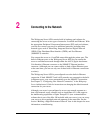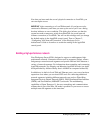
The Workgroup Server 8550 contains built-in hardware and software for
connecting the server to two types of networks: LocalTalk and Ethernet. With
the appropriate Peripheral Component Interconnect (PCI) card and software,
you can also connect your server to additional networks, including other
network types, such as Token Ring, Integrated Services Digital Network
(ISDN), Fiber Distributed Data Interface (FDDI), and Fast Ethernet
(100BASE-T) networks.
You connect the server to a LocalTalk network through the printer port. The
built-in Ethernet ports on the Workgroup Server 8550 let you connect the
server to an Ethernet network through either the AAUI (Apple Attachment
Unit Interface) Ethernet connector or the 10BASE-T Ethernet interface
connector. (Although you can connect cables to both of these Ethernet ports
at the same time, you can use only one of these built-in Ethernet connections
at a time.)
The Workgroup Server 8550 is preconfigured to use the built-in Ethernet
connection. If both 10BASE-T and AAUI networks are connected to the built-
in Ethernet ports, your server automatically uses the 10BASE-T connection.
See Chapter 2, “Configuring Your Network Connection,” in the Wo rk gr ou p
Server Administrator’s Guide for instructions on changing the default network
connection for your server.
Although your server is preconfigured to access one network segment at a
time, with network server software (such as AppleShare 4.2.1) that supports
the multihoming capabilities of Open Transport 1.1 (new communications
software that is part of the Mac OS included with your server), you can set up
your server to access multiple network segments at the same time. See the
section “Building a High-Performance Network” later in this chapter for more
information on multihoming.
2 Connecting to the Network
19


















